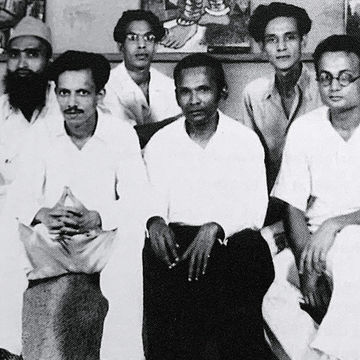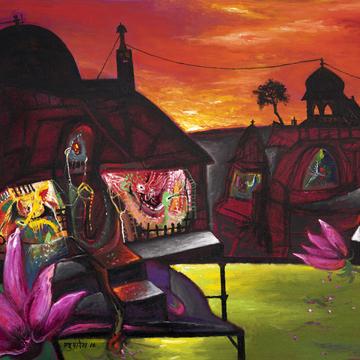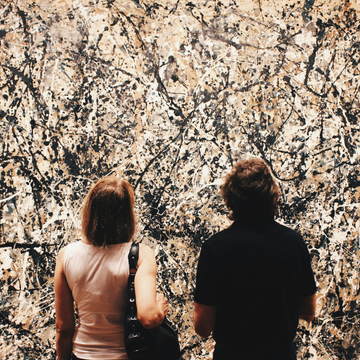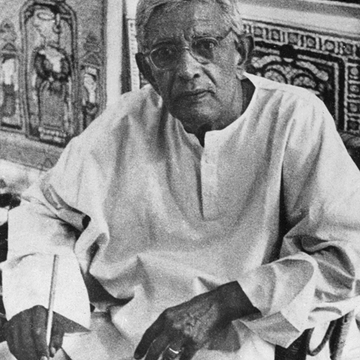Progressive Artists’ Group (PAG): The sextet of artists that incited an artistic revolution in Post-Independence Indi

Author- Ria Sarkar, For Eikowa
The Bombay Progressives were a group of six outstanding artists whose contributions in Indian art are incomparable. In fact these artists and their distinctive styles completely changed the face of Post-Independence Art and went on to form the backbone of what is known as Indian Modern Art today. Up until the 1930’s - 40’s, the British engineered Company school and nationalist art of Bengal was dominating the art scene. But with the expulsion of the ‘British raj’ in 1947, a number of groups sprung up during and after partition that rejected the existing artistic practices in favor of international art styles and movements.
Along with theater artists and writers, visual artists too merged with the former under the banner of “progressive” and identified with Marxism. They had leftist leanings and the title “Progressive” associated them with the Progressive Writers’ Movement, which was started by communist writers and fellow travelers at a conference held in 1936.
The decade 1940-50 saw the rise of artists such as Somnath Hore and Chitta Prasad who drew inspiration from the Bengal Famine while others such as Nirode Mazumdar, Prodosh Das Gupta and Gobardhan Ash formed the Calcutta Group in their attempt to move away from the Bengal school. Before the PAG, refugee artists from Lahore came and set up the Shilpi Chakra Group in 1947, creating a number of channels through which the art scene in India picked up pace, setting the stage for the formation of PAG. Inspired and propelled by the exhibition of the Calcutta Group in Bombay in 1944 and 1945, PAG had its first exhibition of paintings and sculptures in Bombay in July 1949.
Making History: How PAG came together
In 1947, artists F N Souza, M F Husain, S H Raza, H A Gade, K H Ara and S K Bakre (sculptor) came together to form the Progressive Artists Group in Bombay. While they started out as a collective, some of the artists of this group developed a greater maturity in their work individually after 1951 when the group disintegrated and Souza, Raza and Ara went their separate ways.

On December 15 1947, a meeting was held in Bombay during which Souza, Raza, Ara and the critic Rashid Husain spoke about their disappointment regarding the lack of principles in the current judging process of exhibitions. They wanted to break the arbitrary selection process and bring greater transparency in the judging criteria by setting up a Judging Committee so as to create an equal ground for rising artists to exhibit their work. Although the first exhibition of the Progressive Artists Group was held in 1949, the group formally came into being as early as 1947, following this particular meeting.
Before the meeting, Raza, Souza, Bakre and Ara had already met and decided to exhibit their works together. Bakre, being the only sculptor in a group of painters had been convinced by Ara to join in. Soon Souza persuaded Husain while Raza introduced Gade into the PAG bandwagon. Together they decided to limit the number of members at six in order to avoid stylistic scramble. The PAG primarily intended to promote an anti-imperialist outlook and bridge the increasing gap between artists and the life of the people. Later they were to rescind their primary objective as unachievable and focus instead on experimenting with subject matter in their individual styles.
While each of these artists that constituted the PAG produced a large body of work, they were inspired by very varied movements and stylistic influences that made categorizing their work under one school or art style impossible. After three of its members moved abroad in 1951; Souza and Bakre settled in London and Raza went to Paris; the group stopped functioning as a whole and the focus was divided among the artists themselves. Of these, Souza, Raza and Husain were constantly in the limelight, while the others were joined by younger artists such as Tyeb Mehta, Vasudeo S. Gaitonde, etc. under the PAG banner. The Group as such practically disintegrated soon after its joint exhibition with the Calcutta Group held at Calcutta in 1951.

Francis Newton Souza (12 April 1924 – 28 March 2002)
The mastermind and author of the PAG manifesto, Francis Newton Souza played an eminent role in the inception of the Bombay Progressives. His talent in painting was equaled by his proficiency in expressing himself through words. Born in 1924 in Saligao, Goa, Souza lost his father at a very young age. A lot of his work is characterized by his early experiences formed during India’s fight against colonialism. He was expelled for participating in the Quit India Movement while studying at the Sir J J School of Art in Mumbai. His independent and rebellious nature came across on his canvases through disturbing imagery that covered a variety of subjects such as still life, nudes and Christian (Catholic) iconography. His unconventional distortion of form and combination of Goanese folk art with western influences such as Cubism was unprecedented in Indian art. He laid great emphasis on the conflicts and sexual tensions in man-woman relationships and used techniques such as crosshatched strokes to achieve a restless and unrestrained style of painting that became his trademark.

After Souza moved to London in 1949, he officially arrived in the international art scene a few years later with his solo show in Gallery One, simultaneously publishing his autobiographical essay Nirvana of a Maggot. In 1967, he migrated to New York where he received the Guggenheim International Award and remained there till his demise. Much of his artistic career was spent in Europe and America and therefore he is one of the first progressives to be acknowledged for his work on an international level.

Maqbool Fida Husain (17 September 1915 – 9 June 2011)
Hailed as one of the most controversial artists in Indian art history, Maqbool Fida Husain received equal amounts of fame and flak for his radical works. He was born in 1913 in Pandharpur, Maharashtra and came to Mumbai in 1937, unwavering in his goal of becoming a painter. In 1948, he was invited by F N Souza to join the PAG.
Husain’s career had a modest beginning in Mumbai where he painted billboards for feature films and made furniture designs and toys. Later when he had the opportunity to take up painting, he still held on to his roots and inculcated a truly multi-media style, experimenting with photography, installations and eventually even dabbling in filmmaking. His vibrant works were a curious blend of folk and tribal art with elements and figures from Hindu mythology that were striking and much ahead of his time. Cubism, Symbolism and animal imagery were recurring themes in his works. Artistic proficiency aside, his depictions of iconic goddesses in the nude were heavily criticized by the nations pedagogues and orthodox Hindus and deemed blasphemous. After being attacked by Hindu extremists who vandalized his artworks in 1998, Husain was forced to take up self-imposed exile towards the rear end of his life.

In a career that spanned seven decades, Husain created many iconic works such as his series on horses and his portraits of famous Bollywood actresses. With every passing decade his popularity increased nationally and internationally and he became a well-known public figure. He also made feature films, such as Through the Eyes of a Painter, in 1967, which was a Golden Bear Award winner at the Berlin Film Festival, and Gajagamini in 2000. Husain’s contribution to modern Indian art is commendable and his association with the PAG placed him on the map. But it was his dynamic and fearless approach to explore his cultural roots in diverse ways that established him as one of the greatest modern artists in India. The Government of India awarded him the Padma Bhushan and the Padma Vibhushan awards.

M F Husain, Five Horses, 1970, oil on canvas, 32 x 48 in
Sayed Haider Raza (22 February 1922 – 23 July 2016)
Sayed Haider Raza was one of the founders of the Progressive Artists' Group, along with K H Ara and F N Souza. Raza’s works range across a diversity of themes beginning from his childhood memories of growing up in a small town called Babaria in Madhya Pradesh. After receiving a French Government Scholarship in 1950, he left for Ecole Nationale des Beaux-Arts, Paris. Following his relocation to Paris, he began painting landscapes of French towns and villages in an expressionist style, which later transformed into abstract works once his preoccupation with geometric forms set in. In the 1970’s he experimented with line, color and form eventually settling on non-representational imagery. Over the years his style of painting evolved into an eccentric mix of expressionism and geometric abstraction teamed with Indian iconography. 1980 onwards, he explored in great depth the ancient Indian symbolism behind a single point/circle or ‘The Bindu’, which is a Sanskrit word meaning ‘point’ or ‘dot’.

Nature being the predominant theme in his works, Raza was fascinated by the concept of Bindu as a seed that bears the potential of all life; a single point in which the entire universe converges. It also represents a metaphorical space in the mind as the epicenter of our thoughts and essentially our existence. Apart from the Bindu, to which Raza dedicated a significant body of his work, the iconic artist also explored themes of Kundalini, Panch Tatvas and Purush(man)-Prakriti(nature), which again look at the importance of cosmic energy in nature.
He has received numerous awards for his pioneering works including the Prix de la Critique (Paris, 1956) and the Padma Shri and Padma Bhushan by the Govt of India in 1981 and 2007 respectively.

Krishnaji Howlaji Ara (April 16, 1914 – June 30, 1985)
Unlike Souza and Husain who explored various subjects, Krishnaji Howlaji Ara devoted a majority of his career to the female nude. His painting style was initially met with criticism as crude and uninspired, until the critic Rudy Von Leyden from Times of India acknowledged his hidden potential.
Born in 1913 at Bolarum, Andhra Pradesh, Ara was not a trained artist. As the son of a chauffeur, Ara moved to Mumbai at the age of seven and earned his bread by cleaning cars. He joined Mahatma Gandhi’s Satyagraha movement during the struggle for India’s independence and later worked in a number of odd jobs including cleaning cars for a Japanese firm. Painting was his hobby and he devoted all his free time to it, surprisingly even winning prizes in local art competitions, slowly working his way into the art world.

After joining the PAG his repertoire expanded to include still life and human figures along with his long-standing preoccupation with female nudes. His style had an inborn dynamism that comes from meticulous exploration of a subject. After working under the guidance of Leyden and Walter Langhammer, the then art director of Times of India, Ara’s works gained more visibility and acclaim. Critics later recognized his crude rendering as a raw vitality that possessed a spontaneous impressionistic quality.
A key member of the Bombay Art Society since its foundation, Ara was also a part of the selection and judging committee of the Lalit Kala Academy. He was associated with the Artist's Center in Bombay’s thriving art district, where he spent the bulk of his time in later years once his fellow PAG members moved out of India.

Hari Ambadas Gade (August 19, 1917 - December 16, 2001)
Hari Ambadas Gade was an intellectual. He was the only one among the PAG to complete his education till the university level, that too in subjects that were far removed from the field of art. Born in Amravati Andhra Pradesh on, 1917, as a child he loved drawing but he was also good at science and mathematics and went on to pursue degrees in these subjects from Nagpur University. After enrolling as a teacher in Jabalpur, Gade finally started painting landscapes under the guidance of Raza. Much inspired by his friend and fellow PAG member’s expressionist landscapes, Gade developed his own unique style of painting that stand out for their bold vibrant colors.

In retrospect, Gade was one of the first abstract expressionist painters of post-independence India. Gade began by painting watercolors, but he later switched to oils on canvas. He used both the palette knife and brush in his paintings. His works exude a subtle rendering of color and form and his compositions seem to be conceptualized from unusual eye levels. He also had an affinity to paint landscapes from high vantage points.
In his paintings, poverty stricken people and dirty slums of Mumbai crop up once in a while. Yet, he did not abandon his first love, landscapes, and travelled all over India recreating the beautiful Indian landscapes on his canvases.

Sadanand Krishnaji Bakre (10 November 1920 – 18 December 2007)
Sadanand Bakre was the only sculptor in the PAG group. Born in 1920 in Baroda, during his teenage years he worked in Mumbai under the sculptor Raghunath Phadke, who ran a studio famous for producing sculptures in marble and bronze. At Phadke’s studio, Bakre acquired his formative training in sculpting which he explored later in Sir J.J. School of Art. He wanted to be trained in painting but due to financial deficits he was unable to afford the materials needed for the painting course at the time. Fortunately the school faculty and eminent personalities in the Indian art scene such as Rudi Von Leyden and Wayne Hartwell gave him enormous support and encouragement. Through Leyden’s inputs Bakre was exposed to modernism in Europe and America, which aided him in developing his own distinctive style. He was known in later years for his expert handling of color and aesthetic sensibility. After his initial works, he moved away from making representational art and instead attempted to transcend form and capture the true essence of a sculpture or painting. For instance, in Bakre`s portrait sculptures – he was known to brilliantly portray the character of the subject more than their physical and anatomical features.

As a member of the PAG, Bakre did not achieve the iconic status of Souza, Raza or Husain, but the exposure that came with the group was immensely helpful in displaying and selling his works to the public and earn enough money to travel to England. There after a short period of struggle, he finally had the time and money to take up painting and became a member of the New Vision Group, a gathering of non-figurative and abstract artists. After exhibiting with the Group in several shows, including a series in Mumbai in the mid 1960`s, Bakre moved back to India. Till the end he was a man who stayed true to his principles and genuinely believed in painting for the love of it, and not for the money. S K Bakre, Thames, 1969, acrylic on canvas, 31 ½ x 53 1/8”
S K Bakre, Thames, 1969, acrylic on canvas, 31 ½ x 53 1/8”












